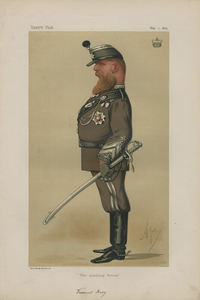7th Earl of Albemarle
|
The Right Honourable The Earl of Albemarle KCMG PC |
|
|---|---|

Viscount Bury, by Carlo Pellegrini, 1875.
|
|
| Under-Secretary of State for War | |
|
In office 4 March 1878 – 21 April 1880 |
|
| Monarch | Victoria |
| Prime Minister | The Earl of Beaconsfield |
| Preceded by | The Earl Cadogan |
| Succeeded by | The Earl of Morley |
|
In office 26 June 1885 – 28 June 1886 |
|
| Monarch | Victoria |
| Prime Minister | The Marquess of Salisbury |
| Preceded by | The Earl of Morley |
| Succeeded by | The Lord Sandhurst |
| Personal details | |
| Born |
William Coutts Keppel 15 April 1832 London, England |
| Died | 28 August 1894 (aged 62) |
| Nationality | British |
| Political party |
Liberal Conservative |
| Spouse(s) | Sophia MacNab (1832–1917) |
| Children |
Arnold Keppel, 8th Earl of Albemarle Hon. Gertrude Keppel Lady Theodora Davidson Hon. Sir Derek Keppel Lady Hilda Keppel Hon. George Keppel Lady Leopoldina Keppel Lady Susan Townley Lady Mary Tagart Florence Boyle, Countess of Cork |
| Parents |
George Keppel, 6th Earl of Albemarle Susan Coutts Trotter |
William Coutts Keppel, 7th Earl of Albemarle, KCMG, PC (15 April 1832 – 28 August 1894), styled Viscount Bury between 1851 and 1891, was a British soldier and politician. He served in the British Army before entering parliament in 1857. Initially a Liberal, he served as Treasurer of the Household between 1859 and 1866 in the Liberal administrations headed by Lord Palmerston and Lord Russell. He later switched to the Conservatives and held office as Under-Secretary of State for War under Lord Beaconsfield between 1878 and 1880 and under Lord Salisbury between 1885 and 1886.
Keppel was born in London, England, the only son of General George Keppel, 6th Earl of Albemarle, by his wife Susan Coutts Trotter, daughter of Sir Coutts Trotter, 1st Baronet. He was educated at Eton. He became known by the courtesy title Viscount Bury when his father succeeded in the earldom of Albemarle in 1851.
Keppel became an ensign and lieutenant in the 43rd (Regiment of) Foot in 1843, a lieutenant in the Scots Guards in 1848 and an aide-de-camp to Lord Frederick FitzClarence in India in 1853. From 1854 until 1856, he was Superintendent of Indian Affairs in Canada.
...
Wikipedia
